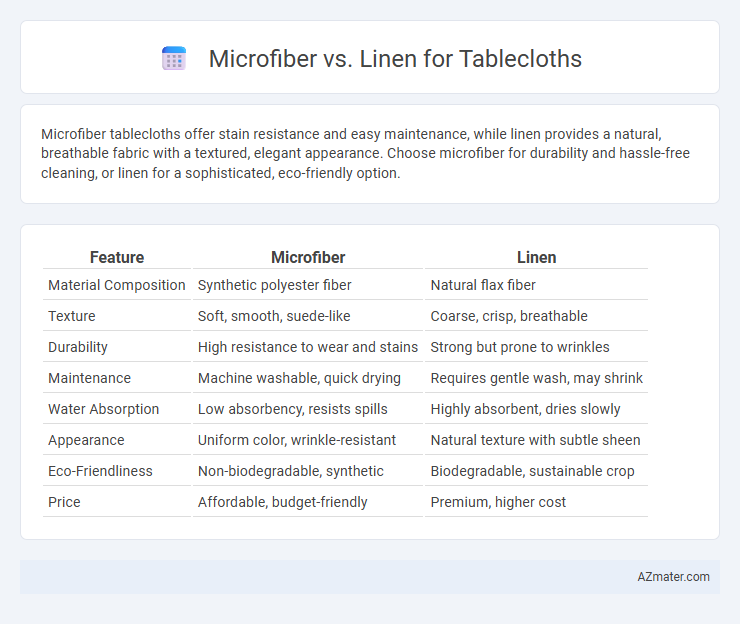Microfiber tablecloths offer stain resistance and easy maintenance, while linen provides a natural, breathable fabric with a textured, elegant appearance. Choose microfiber for durability and hassle-free cleaning, or linen for a sophisticated, eco-friendly option.
Table of Comparison
| Feature | Microfiber | Linen |
|---|---|---|
| Material Composition | Synthetic polyester fiber | Natural flax fiber |
| Texture | Soft, smooth, suede-like | Coarse, crisp, breathable |
| Durability | High resistance to wear and stains | Strong but prone to wrinkles |
| Maintenance | Machine washable, quick drying | Requires gentle wash, may shrink |
| Water Absorption | Low absorbency, resists spills | Highly absorbent, dries slowly |
| Appearance | Uniform color, wrinkle-resistant | Natural texture with subtle sheen |
| Eco-Friendliness | Non-biodegradable, synthetic | Biodegradable, sustainable crop |
| Price | Affordable, budget-friendly | Premium, higher cost |
Introduction to Microfiber and Linen Tablecloths
Microfiber tablecloths offer superior stain resistance, quick drying, and a smooth texture, making them ideal for everyday use and easy maintenance. Linen tablecloths are prized for their natural fibers, breathability, and elegant, textured appearance, which enhances formal dining experiences. Choosing between microfiber and linen depends on priorities such as durability, aesthetic appeal, and care preferences.
Material Composition and Characteristics
Microfiber tablecloths are made from finely woven synthetic fibers, primarily polyester, known for their stain resistance, durability, and wrinkle-free texture. Linen tablecloths consist of natural flax fibers, offering breathability, a luxurious texture, and high absorbency but requiring more delicate care. The synthetic nature of microfiber provides easy maintenance and longevity, while linen's organic composition delivers an elegant, breathable, and eco-friendly option.
Appearance and Texture Comparison
Microfiber tablecloths offer a smooth, wrinkle-resistant surface with a subtle sheen, enhancing a modern and polished look, while linen features a naturally textured weave that provides a rustic, elegant charm with a matte finish. The soft, silky feel of microfiber contrasts with linen's coarser, slightly rough texture that becomes softer over time through use and washing. Both materials vary significantly in appearance and tactile experience, influencing the ambiance and style they bring to a dining setting.
Durability and Longevity
Microfiber tablecloths offer exceptional durability due to their tightly woven synthetic fibers, which resist stains, wrinkles, and wear, ensuring long-lasting use in busy settings. Linen tablecloths, though naturally strong and breathable, tend to wear down faster with frequent washing and rough handling, developing a softer texture but potential thinning over time. For longevity, microfiber provides superior resistance to fading and shrinking, making it an ideal choice for high-traffic dining areas.
Stain Resistance and Ease of Cleaning
Microfiber tablecloths excel in stain resistance due to their tightly woven synthetic fibers that repel liquids and prevent deep penetration, making spills easier to wipe away. Linen tablecloths, while naturally durable, tend to absorb stains more readily and often require prompt and more intensive cleaning methods to avoid permanent marks. Microfiber's quick-drying and machine-washable properties contribute to greater ease of cleaning compared to the more delicate care linen demands, including gentle washing and possible ironing to maintain its texture.
Cost and Affordability
Microfiber tablecloths offer a budget-friendly option with prices typically ranging from $10 to $30, making them accessible for everyday use and large gatherings. Linen tablecloths, known for their premium quality and durability, generally cost between $50 and $150 or more, reflecting higher production costs and natural fabric benefits. Choosing microfiber provides affordability and stain resistance, while linen represents an investment in elegance and long-term use.
Environmental Impact and Sustainability
Microfiber tablecloths, made from synthetic fibers such as polyester, often contribute to microplastic pollution and are less biodegradable, posing long-term environmental challenges. Linen, derived from flax plants, is a natural, renewable resource that requires fewer pesticides and less water during cultivation, making it a more sustainable option. Its biodegradability and durability further enhance linen's eco-friendly profile, positioning it as a preferred choice for environmentally conscious consumers.
Usage Scenarios: Formal vs Informal Settings
Microfiber tablecloths are ideal for informal settings due to their stain resistance, durability, and easy maintenance, making them perfect for casual family meals and outdoor gatherings. Linen tablecloths excel in formal settings, offering a sophisticated, elegant texture and natural breathability that enhances fine dining experiences and special occasions. Choosing between microfiber and linen depends on the event's formality, with microfiber favoring practicality and linen emphasizing luxury.
Maintenance Tips for Microfiber and Linen
Microfiber tablecloths require regular machine washing with mild detergent and low heat drying to maintain their stain resistance and softness, avoiding bleach which can damage fibers. Linen tablecloths benefit from gentle hand washing or a delicate machine cycle with cold water, and should be air-dried or tumble-dried on low to prevent shrinkage and preserve their natural texture. Both fabrics perform best when ironed while slightly damp to remove wrinkles and enhance appearance.
Choosing the Right Tablecloth: Microfiber or Linen?
Microfiber tablecloths offer stain resistance, durability, and easy maintenance, making them ideal for everyday use and casual settings. Linen tablecloths provide a natural, elegant texture with breathable, eco-friendly properties, perfect for formal occasions and adding a sophisticated touch. Selecting the right tablecloth depends on balancing practicality with aesthetics, where microfiber excels in convenience and linen shines in style and sustainability.

Infographic: Microfiber vs Linen for Tablecloth
 azmater.com
azmater.com